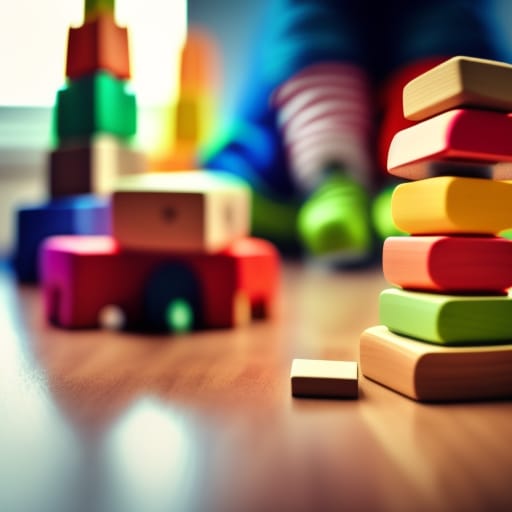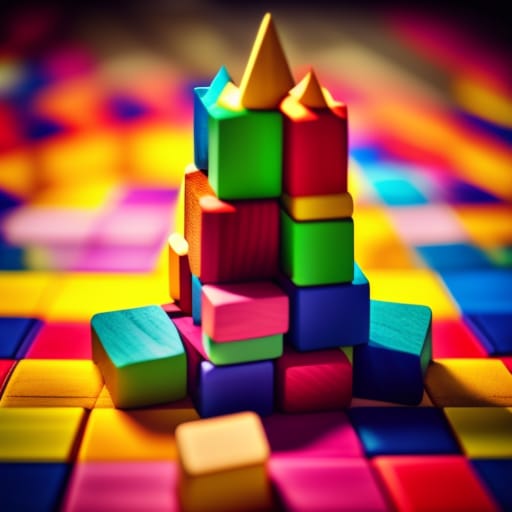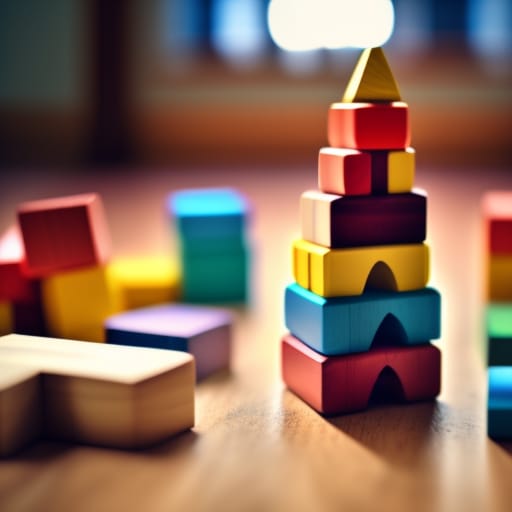Wooden building blocks are timeless toys that have been used for generations to encourage creativity, learning, and fun in children. Simple yet endlessly engaging, these classic blocks inspire imaginative play, develop vital skills, and lay the foundation for a lifelong love of building and design.
In this beginner’s guide, we’ll explore the benefits of wooden blocks, the different types available, key materials and attributes to look for, and tips on choosing the right blocks for your child. Discover how these versatile toys can be used to teach everything from STEM concepts to woodworking basics while providing hours of open-ended play. Let’s rediscover the magic of these back-to-basics blocks!

A Brief History of Wooden Building Blocks
Wooden blocks have been used as children’s toys for centuries, dating back to the 1600s in Europe. The first manufactured wooden alphabet blocks were created in 1837 by Friedrich Fröbel, considered the inventor of kindergarten. His curricular approach emphasized learning through play and exploration.
Fröbel’s visionary educational philosophy laid the foundation for educational toys like wooden blocks that are still popular today. Throughout the 1800s, American companies began mass-producing wooden blocks of all types. By the early 1900s, they became a standard toy found in many households and classrooms.
Though new materials like plastic and electronics have emerged in toys over the decades, classic wooden blocks have stood the test of time. Their enduring popularity speaks to their ability to encourage open-ended, imaginative play and hands-on learning.
The Benefits of Playing with Wooden Building Blocks
It’s easy to see why wooden blocks have been a staple toy for so many generations. Here are some of the key benefits they offer children:
Enhancing Creativity and Imagination
Wooden blocks are an open-ended toy with endless possibilities. They encourage kids to use their creativity as they stack and arrange blocks in unique structures. Making up stories about their block creations builds narrative skills too.
Developing Motor Skills and Coordination
Grasping, lifting, stacking, and balancing blocks help to strengthen children’s hand muscles and improve fine motor coordination. Eye-hand coordination is also boosted as they learn to grasp and place blocks precisely.
Improving Spatial Awareness and Problem-Solving
Judging sizes, shapes, balance, and gravity fosters important spatial perception and problem-solving skills. Children learn concepts like stability as they experiment with different block structures.
Fostering Critical Thinking and Engineering
Planning block structures requires critical thinking about shapes, balance, and design. As children test theories and learn what works through trial and error, they gain early engineering and physics knowledge in action.
Promoting Teamwork and Social Skills
Collaborative play with wooden blocks lets kids negotiate, share ideas, compromise, and work together towards a common goal – great practice for social-emotional skills!
In short, playing with wooden blocks offers a wealth of developmental benefits far beyond just having fun stacking.
Types of Wooden Building Blocks
Wooden blocks come in a wide array of styles and varieties. Here are some of the most common types:
Standard Unit Blocks
These are the classic rectangular prism blocks in graduated sizes. Available in simple natural wood or color-coded with painted edges, they allow for endless construction play.
Specialty and Decorative Blocks
For added architectural detail, specialty blocks offer unique shapes like columns, arches, curves, half circles, spheres, and more. Letter, number, and animal-shaped blocks also fall into this category.
Oversized Blocks
Extra-large blocks like jumbo oversized cubes allow toddlers and young kids to practice skills like stacking, balancing, and knocking down structures. Great for developing spatial awareness!
Stacking Blocks
Blocks with round or tapered edges, like Rainbow Stackers, are designed to be stacked vertically into colorful towers. Stacking develops fine motor control and problem-solving.
Magnetic Blocks
Plastic or wooden blocks embedded with magnets on their sides add STEM appeal. As children experiment with polarity and the attraction/repelling forces, they gain intuition about magnetic fields.
Key Materials for Wooden Blocks
Wooden blocks are most commonly crafted from solid hardwoods or plywoods. Softer woods may dent or show signs of wear more easily. Here are some of the most popular materials used:
- Maple: Very hard and dense with a smooth, light color. Stands up well to wear and tear.
- Oak: Known for strength and stability. Attractive grain patterns. Eco-friendly.
- Beech: Strong hardwood with a light color that stains well. Economical option.
- Pine: Soft, inexpensive wood; may dent over time. Has characteristic knots.
- Birch: Sturdy plywood with attractive veneer patterns in different colors.
- Cherry: Smooth texture. Darkens beautifully over time. Eco-friendly and sustainable.
- Ash: Strong and stable. Pale grain with attractive brown flecks.
When possible, opt for FSC-certified wood from responsible sources. Avoid painted blocks with lead-based paints or toxic stains. Non-toxic food-grade finishes are ideal.
Montessori Learning and Wooden Blocks
The Montessori educational philosophy champions multi-sensory, hands-on learning through self-directed play. Wooden blocks align seamlessly with key Montessori principles:
- Student-driven exploration
- Tactile learning materials
- Fostering independence
- Cognitive development through movement
- Freedom with limits
- Abstract concept introduction
Wooden blocks allow self-paced construction play to learn concepts like shapes, spatial reasoning, geometry, fractions, and more. Combined with other Montessori materials, they provide a rich foundation for math, science, and sensory learning.
Montessori-Inspired Block Activities
Here are a few ways to use wooden blocks to enrich Montessori-style learning:
- Fraction towers: Stack colored blocks in fractional amounts (e.g. 1 whole orange block, 1⁄2 purple block, 1⁄4 green block)
- Block printing: Dip wooden block bases in paint or ink to make printed patterns
- Pink tower: Stack blocks in order of increasing cube dimensions to teach size discrimination
- Sensory exploration: Experiment with temperature contrasts (blocks from the freezer vs. wood stove)
Wooden Blocks in Waldorf Education
Developed by Rudolf Steiner, Waldorf education aims to nurture a child’s head, heart, and hands. Wooden toys like blocks integrate beautifully into the Waldorf approach. Key principles include:
- Emphasis on imagination, creativity, and exploration
- Minimal reliance on media and technology
- Learning by doing with natural tactile materials
- Wooden toys to develop coordination and open-ended play
Waldorf classrooms are filled with simple, natural wooden toys like blocks to engage the senses and inspire creative, unstructured play. Teachers lead the child from play to focused activity to academic study over time.
Waldorf-Inspired Block Play
Wooden blocks lend themselves perfectly to many aspects of the Waldorf method:
- Storytelling: Create vivid stories around block structures
- Artwork: Arrange blocks into nature patterns and shapes
- Music: Tap out rhythms by clapping blocks together
- Movement: Build crawling/walking obstacle courses with blocks

Early STEM Skills with Wooden Blocks
Wooden blocks are the perfect tool to introduce core STEM (Science, Technology, Engineering, and Math) concepts to young children through interactive play. Here are some key skills kids can begin building:
Science
- Experiment with gravity, friction, motion, and cause-and-effect
- Explore concepts like balance, stability, and mechanical advantage
- Classify blocks by shape, size, color, texture, and weight
Technology
- Problem solve by envisioning structures and bringing ideas to life
- Use mechanical principles to build bridges, houses, towers, etc.
- Combine blocks with other elements like ramps or pulleys
Engineering
- Test design ideas, modify when needed, and evaluate structure integrity
- Discover concepts like tension, compression, and distribution of weight
- Apply engineering and physics principles to build structurally sound creations
Math
- Learn shapes, patterns, symmetry, fractions, and spatial reasoning
- Count, add, and multiply blocks in different arrangements
- Weigh and compare blocks to understand volume and density
The hands-on application of STEM principles through wooden block play creates a natural foundation for further science exploration.
Fun STEM Block Activities
- Build a zoo, with each animal’s home representing its natural habitat
- Challenge kids to build the tallest freestanding tower possible
- Engineer a bridge strong enough for a toy car to cross without collapsing
- Combine blocks with marbles or golf balls to create ramps and observe motion
Architecture and Design with Wooden Blocks
Wooden blocks offer an ideal entry point to introduce young children to architecture and design concepts by building:
- Bridges
- Skyscrapers
- Castles
- Tunnels
- Enclosed structures with room inside
- Geometric patterns
- Mosaics and pixel art
As they position blocks, kids gain spatial reasoning skills and intuition for design basics:
- Structural balance
- Arch formation
- Foundations and weight distribution
- Scale, dimension, and proportion
- Symmetry
- Negative space
Add specialty blocks like columns, curves, spheres, pyramids, cubes, etc. to expand architectural possibilities. Acting out narratives about their block creations builds storytelling and imaginative play.
Architecture and Design Inspired Play
- Build real architectural wonders like the Colosseum or Taj Mahal
- Recreate cityscapes with bridges, homes, parks, and skyscrapers
- Design fantasy castles, forts, or underground labyrinths
- Construct block mosaics or geometric patterns
- Use blocks to model floorplans for dollhouses or other structures
Introduction to Woodworking with Blocks
For a playful introduction to woodworking skills, wooden blocks offer many cross-over teaching opportunities, including:
Wood Types
- Recognize common woods like oak, maple, and pine by color, grain size, texture
Joinery
- Stack blocks in different arrangements to make structures
- Experiment with stability vs. weakness in structural joints
Tools
- Use toy mallets, hammers, nails, screws to build with blocks
- Pretend to saw, drill, and chisel blocks during play
Finishing
- Feel the difference between natural, stained, and painted block finishes
- Protect structures with pretend varnish or sealant
Safety
- Keep the work area free of clutter to avoid accidents
- Follow guidelines like no throwing blocks
Reinforce these introductory concepts with supervised hands-on experience sawing, sanding, and hammering child-safe wood pieces when appropriate.
Early Woodworking Block Play
- Set up a pretend workshop area with toy tools and blocks
- Make custom blocks from wood slices kids can decorate
- Use blocks to demonstrate how joints connect pieces together
- Build block gadgets like pretend vices, clamps, workbenches
How to Choose the Right Wooden Blocks
With so many varieties available, here are tips for selecting the best wooden blocks for your child:
Age Appropriateness
- Chunky blocks for toddlers
- Smaller blocks for developing coordination and dexterity in preschoolers
- Look for sets that grow with kids from tots to tweens
Safety
- Solid hardwood avoids the dangers of splintering
- Non-toxic, child-safe finishes only
- No small parts if under 3 years old
Quality and Durability
- Tight precision fits withstand frequent use
- Hardwoods avoid dents that come with cheaper softwoods
- Reinforced storage bags keep all pieces together
Variety
- The more shape variety the better to encourage creativity
- Specialty blocks like arches and curves add dimension
- Consider alphabet, number, and animal blocks too
Eco-Friendliness
- FSC-certified and sustainably sourced woods are ideal
- Avoid plastics and seek natural, recyclable materials
Ask knowledgeable store staff for advice and let kids test blocks for texture, weight, and sturdiness. Higher-quality sets designed for longevity are cost-effective in the long run.

Top 5 Wooden Block Picks
Here are our top recommendations for quality wooden block sets that inspire creative play and learning:
Grimm’s Rainbow Stacker – $75
This stunning heirloom-quality set of color-coded beechwood stacking blocks develops coordination and problem solving.
Maple Unit Blocks – $85
Classic open-ended construction play with 100+ maple blocks in squares and rectangles.
Lovevery Block Set – $80
This 40-piece set grows with kids from ages 1 through 4 with designs that increase in complexity.
Tegu Magnetic Wooden Blocks – $149
Endlessly buildable magnetic blocks engage STEM learning and introduce polarity concepts.
Woodpeckers Giant Wooden Blocks– $99
With 12 giant blocks sized 3” to 9”, kids can build big right from the start!
Take time to evaluate the feel and quality of blocks in person. Higher price often (but not always) indicates better materials, precision, and durability.
Encouraging Open-Ended Block Play
Wooden blocks offer an unlimited canvas for creativity and learning through play. Here are tips for getting the most out of block playtime:
- Let kids set the agenda – resist dictating what to build
- Ask open questions to spur imagination e.g. I wonder what could happen next? How could you solve this problem?
- Suggest challenges e.g. Can you build something taller than yourself?
- Introduce new materials like scarves or cardboard tubes to spark ideas
- Weave stories around structures as they build e.g. “The tunnel led to a secret castle…”
- Get involved at their invitation, but don’t direct or take over
- Let creations spark teachable moments e.g. counting blocks, identifying shapes
- Most importantly, step back and let play flow from their inventive minds!
The ability to lose oneself in hours of imaginative block play is a hallmark of childhood. Give kids the space for this self-directed exploration and learning through wooden blocks.
Conclusion: Timeless Wooden Blocks Foster Learning Through Play
For over a century, classic wooden blocks have encouraged freeform, and imaginative play and built core skills from STEM to socialization. Their simplicity allows for unlimited open-ended play possibilities suited to every child’s unique interests and abilities.
From toddlers grasping their first blocks to school-aged kids designing intricate structures, wooden blocks instill a sense of accomplishment, confidence, and curiosity with hands-on learning. They inspire children to unpack their creativity in a screen-free, tactile environment.
While new high-tech toys come and go, these back-to-basics blocks have stood the test of time. Their exceptional value in building vital developmental skills makes them well worth introducing to a new generation of children. Discover the magic today!
Frequently Asked Questions
What are the main benefits of wooden blocks?
Wooden blocks offer many developmental benefits for children including enhancing creativity, building STEM skills, and improving hand-eye coordination. Unstructured block play fosters vital skills like spatial reasoning, problem-solving, and imagination.
How do I choose good quality wooden blocks?
Look for solid hardwood blocks made from maple, oak, or beech rather than cheaper softwoods that dent easily. Ensure blocks have a non-toxic finish. Well-made sets feature tightly precision-fit blocks in a variety of shapes and sizes.
What’s the best age for introducing wooden blocks?
Chunky wooden blocks can be used safely starting around 12 months. Around 2-3 years old, kids have the coordination for smaller unit blocks to build structures. Open-ended block play engages kids up to age 10.
Can wooden blocks really help teach STEM skills?
Building various structures like bridges, houses, and towers lets kids explore engineering, architecture, and physics concepts like balance, tension, compression, and gravity through hands-on play.
How do wooden blocks compare to plastic blocks?
Wooden blocks offer a warmer, more natural tactile experience and classic aesthetic. Made from sustainably sourced wood, they’re also more eco-friendly than plastic options. Wooden blocks tend to be of higher quality for improved durability.
Notes for the writer:
- Incorporate the LSI keywords naturally into the FAQs, using proper keyword optimization best practices like putting keywords in bold or italics.
- Make sure the questions are logical follow-up questions a reader might have after reading the article.
- Provide insightful answers that would give readers helpful information related to wooden blocks.
- Aim for 5-7 FAQs total to cover common reader questions.